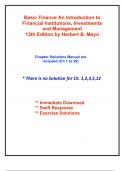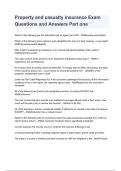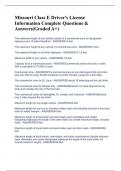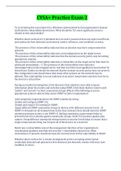Basic Finance An Introduction to
Financial Institutions, Investments
and Management
13th Edition by Herbert B. Mayo
Chapter Solutions Manual are
included (Ch 1 to 29)
* There is no Solution for Ch. 1,2,3,5,12
** Immediate Download
** Swift Response
** Exercise Solutions
,Solution and Answer Guide
Mayo/Lavelle, Basic Finance: An Introduction to Financial
Institutions, Investments, and Management
Chapter 4: Securities Markets
EXERCISE SOLUTIONS
1. You purchase 100 shares for $50 per share ($5,000), and after a year the price rises to $60. What will be the
percentage return on your investment if you bought the stock on margin and the margin requirement was
(a) 25 percent, (b) 50 percent, and (c) 75 percent? (Ignore commissions, dividends, and interest expense.)
Solution
If the stock rises from $50 to $60, the gain is $1,000 on the purchase of 100 shares. The return on the
individual's investment depends on the amount of margin.
a. If the margin requirement is 25 percent, the amount the investor must put up is $1,250 (0.25 x $5,000),
so the return is $1,000/$1,250 = 80%.
b. If the margin requirement is 50 percent, the return is 40 percent ($1,000/$2,500).
c. If the margin requirement is 75 percent, the required margin is $3,750 and the return is 26.7 percent
($1,000/$3,750).
Be certain to point out the $1,000 capital gain is the same in all three cases but that the percentage return
differs because the amount put up by the investor differs in each case.
2. Repeat Exercise 1 to determine the percentage return on your investment, but in this case suppose the price
of the stock falls to $40 per share. What generalization can be inferred from your answers to Problems 1
and 2?
Solution
If the stock declines from $50 to $40, the loss is $1,000 on the purchase of 100 shares. The return on the
individual's investment once again depends on the amount of margin.
a. If the margin requirement is 25 percent, the amount the investor must put up is $1,250, and the return is
$1,000/$1,250 = −80%.
b. If the margin requirement is 50 percent, the return is −40 percent ($1,000/$2,500).
c. If the margin requirement is 75 percent, the percentage loss is −26.73 percent ($1,000/$3,750).
The generalization from Problems (1) and (2) is that the percentage return is affected by the amount of
margin and that the lower the margin requirement, the greater is the potential swing in the return on the
investor's funds.
3. A stock is currently selling for $45 per share. What is the gain or loss on the following transactions?
Solution
a. $41.50 − $45 = −$3.50
b. $45 − $41.50 = $3.50
c. $54 − $45 = $9
d. $45 − $54 = −$9
, In each case, the sale price is subtracted from the purchase price to determine the profit or loss. Be certain
to point out that the sale may occur before the purchase, which is the case in each of the short sales.
4. A sophisticated investor, B. Graham, sold 500 shares short of Amwell, Inc. at $42 per share. The price of
the stock subsequently fell to $38 before rising to $49 at which time Graham covered the position (that is,
purchased shares to close the short position). What was the percentage gain or loss on this investment?
Solution
Unfortunately, investor Graham did not cover the short sale after the stock declined but waited until the
price of the stock rose and thus sustained a loss of $7 per share for a total loss of $3,500.
5. A year ago, Kim Altman purchased 200 shares of BLK, Inc. for $25.50 on margin. At that time the margin
requirement was 40 percent. If the interest rate on borrowed funds was 9 percent and she sold the stock for
$34, what is the percentage return on the funds she invested in the stock?
Solution
Cost of the shares: 200 × $25.50 = $5,100
Margin: $5,100 × 0.40 = $2,040
Funds borrowed: $5,100 − $2,040 = $3,060
Interest paid: $3,060 × 0.09 = $275.40
Profit on the stock: $6,800 − $5,100 = $1,700
Return on the investment: ($1,700 − $275.40)/$2,040 = 69.8%
6. Barbara buys 100 shares of DEM at $35 per share and 200 shares of GOP at $40 per share. They buy on
margin and the broker charges interest of 10 percent on the loan.
Solution
100 shares of DEM at $35 $3,500
200 shares of GOP at $40 $8,000
Total cost of securities $11,500
a. Required margin: 0.55 × $11,500 = $6,325
Amount borrowed: $11,500 − $6,325 = $5,175
b. Interest expense: 0.10 × $5,175 = $517.50
c. Loss on DEM stock: $2,900 − $3,500 = −$600
Loss on GOP stock: $6,400 − $8,000 = −$1,600
Net loss: −$2,200
d. Percentage loss including interest:
−($2,200 + $517.50)/$6,325 = −43%
, 7. After an analysis of Lion/Bear, Inc., Karl O’Grady has concluded that the firm will face financial difficulty
within a year. The stock is currently selling for $5 and O’Grady wants to sell it short. His broker is willing
to execute the transaction, but only if O’Grady puts up cash as collateral equal to the amount of the short
sale. If O’Grady does sell the stock short, what is the percentage return he loses if the price of the stock
rises to $7? What would be the percentage return if the firm went bankrupt and folded?
Solution
Since the stock is sold short, the price increase causes a loss of $2 ($5 − $7) per share. Since Mr. O'Grady
put up 100 percent margin, the percentage loss is
−$2/$5 = −40.0%
If the price of the stock declined to $0, the percentage return is 100 percent.
Be certain to point out that the largest gain to the short seller occurs if the price of the stock declines to
zero, while in a long position there is no limit to the possible price increase. Of course, in most cases, the
price of the stock does not decline to zero, nor does it rise indefinitely.
8. Lisa Lasher buys 400 shares of stock on margin at $18 per share. If the margin requirement is 50 percent,
how much must the stock rise for them to realize a
25-percent return on their invested funds? (Ignore dividends, commissions, and interest on borrowed
funds.)
Solution
The initial investment is $18 × 400 × 0.50 = $3,600. To realize a 25 percent return, the value of the position
in the stock must rise by $900 (0.25 × $3,600). The stock must increase by $2.25 per share ($900/400
shares = $2.25).
9. A broker quotes GameStop stock (GME) with a bid-ask of $93.52–$93.62. You buy 10 shares and then
immediately decide to sell your 10 shares. The stock price has not changed at all, and there are no
commissions or taxes. How much money do you lose?
Solution
You buy at the higher price that the broker is asking: 10 shares × $93.62 = $936.20. You sell at the lower
price that the broker is bidding: 10 shares × $93.52 = $935.20. You receive only $935.20 after paying
$936.20, so you lose $1.00.
10. A broker quotes AMC Entertainment Holdings (AMC), a movie theater chain, at a bid-ask of $15.94–
$16.14 and you decide to buy 100 shares. The next day the stock price has changed, and the broker quotes a
bid-ask of $14.52–$14.72, and you sell your 100 shares. How much have you gained or lost?
Solution
You buy at the higher ask price on the first day: 100 shares × $16.41 = $1,641. You sell at the lower bid
price the next day: 100 shares × 14.52 = $1,452. $1,452 − $1,641 = a loss of $189.







